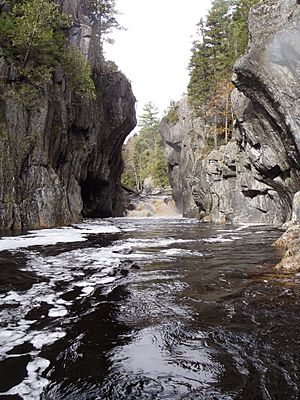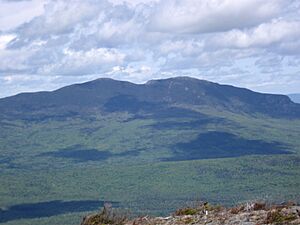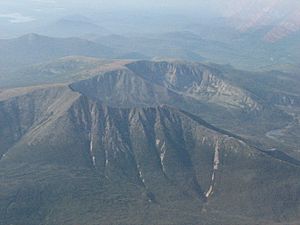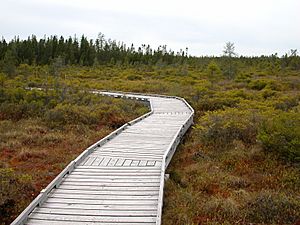List of National Natural Landmarks in Maine facts for kids
These are 14 National Natural Landmarks in Maine. These special places are recognized for their amazing natural features. They show off the best examples of America's natural history.
Contents
Maine's Natural Wonders
Maine is home to many incredible natural spots. The National Natural Landmark program helps protect these unique areas. Each landmark has something special, from ancient forests to unique bogs and stunning mountains. Let's explore some of these natural treasures!
Appleton Bog Atlantic White Cedar Stand
This landmark is a huge peatland. A peatland is a type of wetland where dead plant material builds up over thousands of years, forming a thick layer called peat. This bog has a continuous forest of Atlantic white cedar trees. It also has a special "hummock-and-hollow" surface. This means it has small mounds (hummocks) and dips (hollows) that create different mini-habitats. It was recognized in 1984 and is privately owned in Knox County.
Carrying Place Cove Bog
This unique spot is a tombolo that has been shaped by the sea. A tombolo is a sandy strip of land that connects an island to the mainland or to another island. Over time, the ocean has eroded parts of this tombolo. It became a landmark in 1980 and is a state-owned site in Washington County.
Colby-Marston Preserve
The Colby-Marston Preserve is a northern sphagnum bog. A sphagnum bog is a wetland dominated by sphagnum moss, which can hold a lot of water. This bog is found in a deep kettle hole. A kettle hole is a shallow, sediment-filled body of water formed by melting glaciers. The moss mat here is incredibly deep, more than 40 feet (12 meters) thick! This private landmark in Kennebec County was designated in 1973.
Crystal Bog
Crystal Bog is known as one of Maine's largest and most beautiful undisturbed sphagnum bogs. It's a fantastic example of this type of wetland, showing how nature can thrive without much human interference. This private landmark in Aroostook County was recognized in 1973.
Gulf Hagas
Gulf Hagas is often called the "Grand Canyon of Maine." It features stunning waterfalls and tall cliffs. The gorge walls are covered with a beautiful spruce-fir forest. This combination of water, rock, and trees makes it an incredibly scenic place. It was named a landmark in 1968 and is part of the federal Appalachian Trail system in Piscataquis County.
The Hermitage
The Hermitage is a very special place because it holds one of the few remaining undisturbed, old-growth white pine forests in New England. "Old-growth" means the trees are very old and have never been cut down. These towering white pines offer a glimpse into what forests looked like centuries ago. This federal landmark, also part of the Appalachian Trail, was designated in 1977 in Piscataquis County.
Monhegan Island
Monhegan Island is famous for its dense forests of red spruce trees. It's also a paradise for plant lovers, with over 400 different species of wildflowers. The island's unique ecosystem makes it a valuable natural site. This private landmark in Lincoln County was recognized in 1966.
Mount Bigelow
Mount Bigelow offers some of the most breathtaking views in the eastern United States. It's known for its wild and exceptionally scenic landscape. Hikers and nature lovers enjoy its rugged beauty and wide-open vistas. This state-owned landmark, located in Franklin and Somerset counties, was designated in 1975.
Mount Katahdin
Mount Katahdin is not just Maine's highest peak; it's also a fantastic outdoor classroom for geology. The area around the mountain shows clear signs of glaciers that once covered the land. You can see features like kames (small hills of sand and gravel), eskers (long, winding ridges), drumlins (oval-shaped hills), kettleholes, moraines, and erratics (large rocks left by glaciers). These features provide a complete picture of how glaciers shaped the landscape. This state-owned landmark, located in Baxter State Park in Piscataquis County, was recognized in 1967.
New Gloucester Black Gum Stand
This landmark is a small, untouched forested swamp. It's mostly dominated by virgin black gum trees. "Virgin" means these trees have never been logged or disturbed by humans. It's a rare example of this type of forest. This private landmark in Cumberland County was designated in 1975.
No. 5 Bog and Jack Pine Stand
No. 5 Bog is a large peatland located between mountains. It's one of the few vast, untouched natural areas left in the northeastern United States. This landmark also features a stand of jack pine trees. It's a mix of state and privately owned land in Somerset County and was recognized in 1984.
Orono Bog
Orono Bog is considered a classic example of a northern sphagnum bog. It's a great place to see the unique plants and conditions that make up this type of wetland. It's a mix of municipal and privately owned land in Penobscot County and was designated in 1973.
Passadumkeag Marsh and Bogland
This landmark is one of the largest and most unspoiled wetlands in the entire state of Maine. It's a vast area of marsh and bogland that provides important habitat for many plants and animals. This private landmark in Penobscot County was recognized in 1973.
Penny Pond-Joe Pond Complex
This complex includes several kettle hole bogs and ponds. As mentioned before, kettle holes are depressions formed by melting glaciers. These bogs and ponds are important for studying wetland ecosystems. This private landmark in Kennebec County was designated in 1973.







